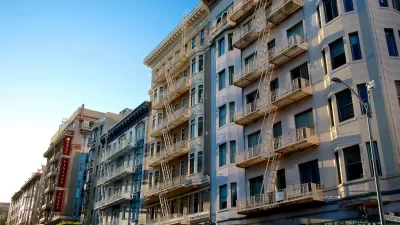A zoning history dating back to the 19th century still has significant impacts on the city’s housing in the present day.

Hunter Oatman-Stanford considers where San Francisco finds itself today in terms of housing by tracing a path that began with the city’s earliest zoning policies. He starts with an 1870 ordinance that required boarding houses to provide tenants with a minimum amount of space, a law that proponents argued was necessary to improve the quality of life of city residents:
But the law’s true purpose—to criminalize Chinese renters and landlords so their jobs and living space could be reclaimed for San Francisco’s white residents—set an ominous precedent. With the Cubic Air Ordinance, city leaders laid the groundwork for 150 years of exclusionary zoning or land-use policy designed to protect the status quo, rather than responsibly manage growth.
In the decades after the 1906 earthquake, San Francisco started to implement zoning regulations, which were promoted as a way to control industrialization and ensure public safety. In reality, they served to exclude people from particular neighborhoods based on race and class. Prohibition of certain types of businesses, racial covenants, and height restrictions all limited access for some people while promoting the interests of wealthier San Francisco residents.
The city planning department was formally established in 1942, and the 1945 general plan targeted parts of the city deemed problematic and in need of redevelopment. These were more often than not disenfranchised communities. “Those ‘blighted’ parts the plan identified just so happened to be the working-class neighborhoods mostly populated by people of color: the Western Addition, South of Market, Chinatown, the Mission, and the Bayview-Hunter’s Point,” says Oatman-Stanford.
Oatman-Stanford explains that during this same period the Federal Housing Administration’s guidelines were supporting “redlining,” where particular neighborhoods, exclusively white ones, were deemed desirable for lenders while others were considered risky. What was happening at the federal level influenced neighborhoods in San Francisco, he says:
While the federal government was assisting white families in seeking the “American dream” of homeownership, it was conspiring to deny the same opportunities to people of color. On a local level, San Francisco leaders engineered the destruction of the city’s thriving African American community by forcibly evicting residents and businesses in the name of urban renewal, knowing full well they wouldn’t be able to relocate in the city’s other central neighborhoods.
Oatman-Stanford also cites a change in 1954 that allowed discretionary review as an important turning point for San Francisco. “The absence of ‘by-right’ approval meant that even if a project met all zoning requirements, anyone with enough time and money could pay to appeal the development and attempt to trigger a discretionary-review hearing, which often added months or years of delays to the approval process,” he says. This in essence meant that the party with the most resources, generally financial ones, would prevail in a zoning dispute.
Starting in the late 1950s, San Francisco saw the rise of grassroots environmental and anti-growth movements, which started with public resistance to a proposal for a freeway network across the city. The Residential Rezoning of 1978 legislation mandated height limits, new setback regulations, low-density requirements, and design regulations – necessary, argued supporters, for maintaining neighborhood character. While this project disproportionately would affect low-income residents, hamper efforts to build affordable housing, and inevitably increase housing costs, the planning commission’s priorities were focused elsewhere, says Oatman-Stanford:
It’s clear that many San Franciscans were well aware this rezoning would lead the city toward a housing crisis. The planning commissioners, however, were not moved. Their testimony throughout the hearings made it clear they valued maintaining the city’s predominately suburban layout over affordability.
With these zoning regulations in place, residential development started moving to industrial parts of the city. Development in downtown San Francisco continued, and concern grew about residents who would be displaced from adjacent lower-income, higher-density, mixed-use neighborhoods. Oatman-Stanford describes what happened in the Tenderloin, a neighborhood that managed to stay relatively stable:
After three high-rise tourist hotels were planned for the neighborhood’s border with Union Square in 1980, activists managed to convince the city to establish new zoning controls that would retain the area’s residential buildings and limit new growth to between 8 and 13 stories. In contrast to the suburban downzoning of wealthier neighborhoods, the Tenderloin’s residential density was prioritized in order to maintain affordability.
Continued advocacy in the Tenderloin and work by the planning department demonstrated that zoning could protect residents in low-income neighborhoods. But, points out Oatman-Stanford, anti-growth sentiments continued to dominate in San Francisco and public resistance to density, in the form of apartment buildings, did not abate. In addition, a 2008 plan to revamp the city’s discretionary review policies never came to fruition.
Some anti-growth advocates look back and regret the effects of suburban zoning, in a city with housing costs spiraling out of control and inadequate affordable housing. Still, says Oatman-Stanford, no one is proactively working to change zoning regulations that would promote density:
Instead, anti-growth residents continue to sink development projects, ranging from an all affordable senior-housing complex to a downtown high-rise development that would cast a partial shadow over a condo building’s courtyard pool. The city’s planning department and planning commission (whose members are overwhelmingly homeowners in a majority-renter city) remain complicit in obstructing all kinds of new housing in order to preserve most of the city’s neighborhoods exactly as they are, crisis be damned.
However, there are some glimmers of rising opposition, reports Oatman-Stanford, particularly from younger residents who cannot afford San Francisco. In addition, election of a mayor endorsed by a pro-housing constituent group and calls from local publications for increased and expedited housing construction signal a possible shift in public sentiment.
FULL STORY: Demolishing the California Dream: How San Francisco Planned Its Own Housing Crisis

Study: Maui’s Plan to Convert Vacation Rentals to Long-Term Housing Could Cause Nearly $1 Billion Economic Loss
The plan would reduce visitor accommodation by 25,% resulting in 1,900 jobs lost.

Alabama: Trump Terminates Settlements for Black Communities Harmed By Raw Sewage
Trump deemed the landmark civil rights agreement “illegal DEI and environmental justice policy.”

Why Should We Subsidize Public Transportation?
Many public transit agencies face financial stress due to rising costs, declining fare revenue, and declining subsidies. Transit advocates must provide a strong business case for increasing public transit funding.

Paris Bike Boom Leads to Steep Drop in Air Pollution
The French city’s air quality has improved dramatically in the past 20 years, coinciding with a growth in cycling.

Why Housing Costs More to Build in California Than in Texas
Hard costs like labor and materials combined with ‘soft’ costs such as permitting make building in the San Francisco Bay Area almost three times as costly as in Texas cities.

San Diego County Sees a Rise in Urban Coyotes
San Diego County experiences a rise in urban coyotes, as sightings become prevalent throughout its urban neighbourhoods and surrounding areas.
Urban Design for Planners 1: Software Tools
This six-course series explores essential urban design concepts using open source software and equips planners with the tools they need to participate fully in the urban design process.
Planning for Universal Design
Learn the tools for implementing Universal Design in planning regulations.
Smith Gee Studio
Alamo Area Metropolitan Planning Organization
City of Santa Clarita
Institute for Housing and Urban Development Studies (IHS)
City of Grandview
Harvard GSD Executive Education
Toledo-Lucas County Plan Commissions
Salt Lake City
NYU Wagner Graduate School of Public Service





























